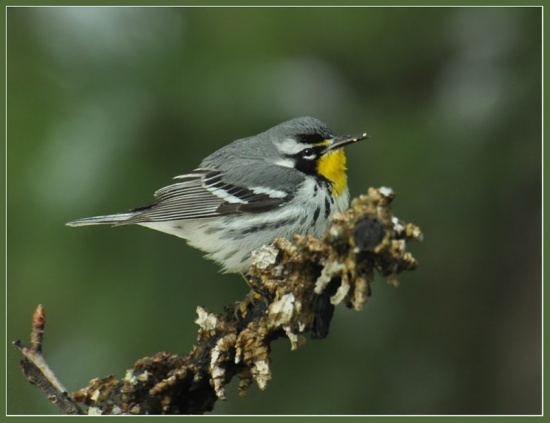Includes Bahama Warbler
- Dendroica dominica
Identification
5" (13 cm). Grey, unstreaked upperparts, bright yellow throat, white belly, black-and-white facial pattern, heavy black streaks on sides. Sexes alike.
Variation
The Bahamas subspecies (Bahama Warbler) has yellow from throat to belly where it fades into white explaining the older name, Yellow-breasted Warbler. In measurements, this form has longer but narrower bill, longer tarsus, longer tail, but shorter wing.
Distribution
Breeds from Illinois, Ohio, and New Jersey south to Missouri, Texas, Gulf Coast, and northern Florida. Occasionally it may stray, and even breed, as far north of its usual range as New York and southern New England. Winters from Gulf Coast states southward.
Also breeds in the Bahamas (Abaco and Grand Bahama).
Taxonomy
Four subspecies are recognized1.
- D. d. albilora - breeds se. Iowa south to e. Texas e. to Pennsylvania, western Carolinas, and northwestern Alabama
- D. d. dominica - breeds along the Atlantic coastal plain from s. New Jersey south to cen. Florida w. to Alabama
- D. d. flavescens - breeds in the Bahamas
- D. d. stoddardi - breeds along coastal Florida panhandle and adjacent Alabama
Subspecies flavescens has been proposed for elevation to status of full species named Bahama Warbler. On the other hand, the subspecies albilora and stoddardi are sometimes seen as synonymous with dominica.
Habitat
Forests of pine, cypress, sycamore, and oak, in both swampy places and dry uplands. This attractive warbler is usually found in live oaks draped with Spanish moss or in longleaf pines.
The Bahama population birds are specialized to forage in forest of Caribbean Pine.
Behaviour
It often creeps over the branches of the trunk like a Black-and-white Warbler.
Breeding: 4 purple-spotted greenish eggs in a nest of grass and bark strips lined with hair and feathers, often set in clumps of Spanish moss or among pine needles.
Voice: The form breeding in the USA uses a series of clear ringing notes descending in pitch and increasing in speed, rising abruptly at the end, teeew-teeew-teeew-teeew-tew-tew-twi. The Bahama form sings an ascending series of notes.
References
- Clements, James F. 2007. The Clements Checklist of Birds of the World. 6th ed., with updates to October 2007. Ithaca: Cornell University Press. ISBN 9780801445019
- BirdForum thread discussing the proposal to see flavescens as a full species
Recommended Citation
- BirdForum Opus contributors. (2024) Yellow-throated Warbler. In: BirdForum, the forum for wild birds and birding. Retrieved 4 May 2024 from https://www.birdforum.net/opus/Yellow-throated_Warbler




